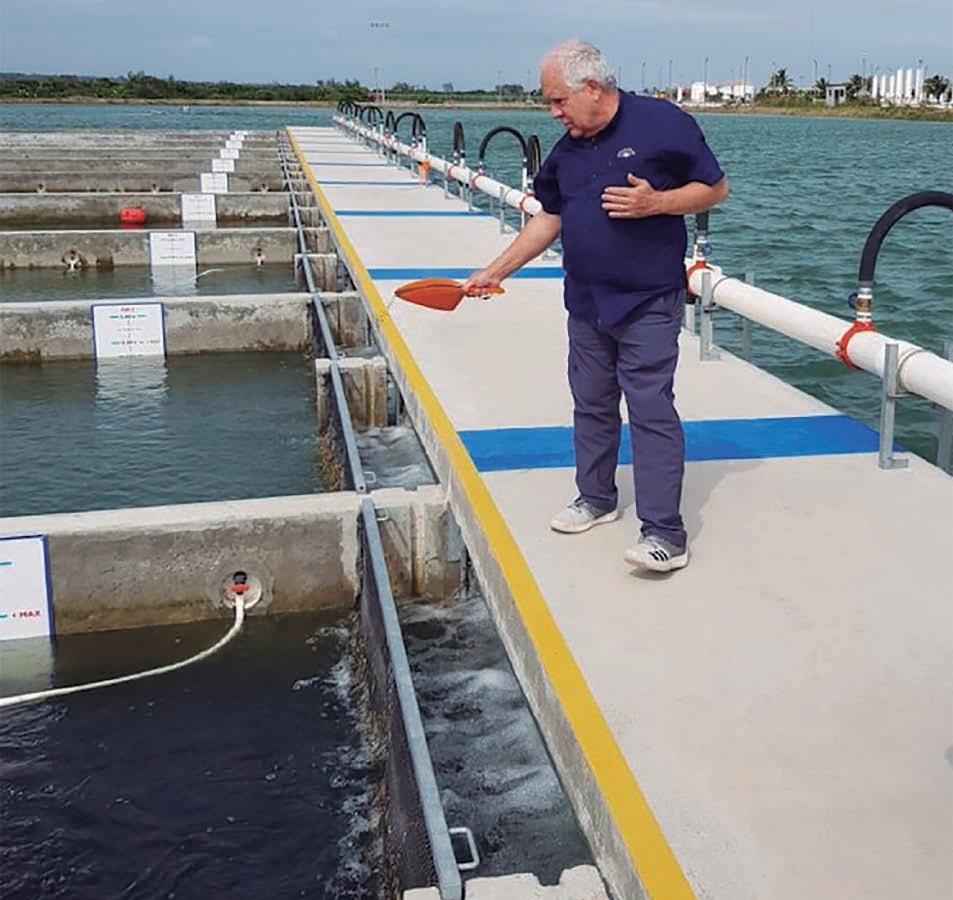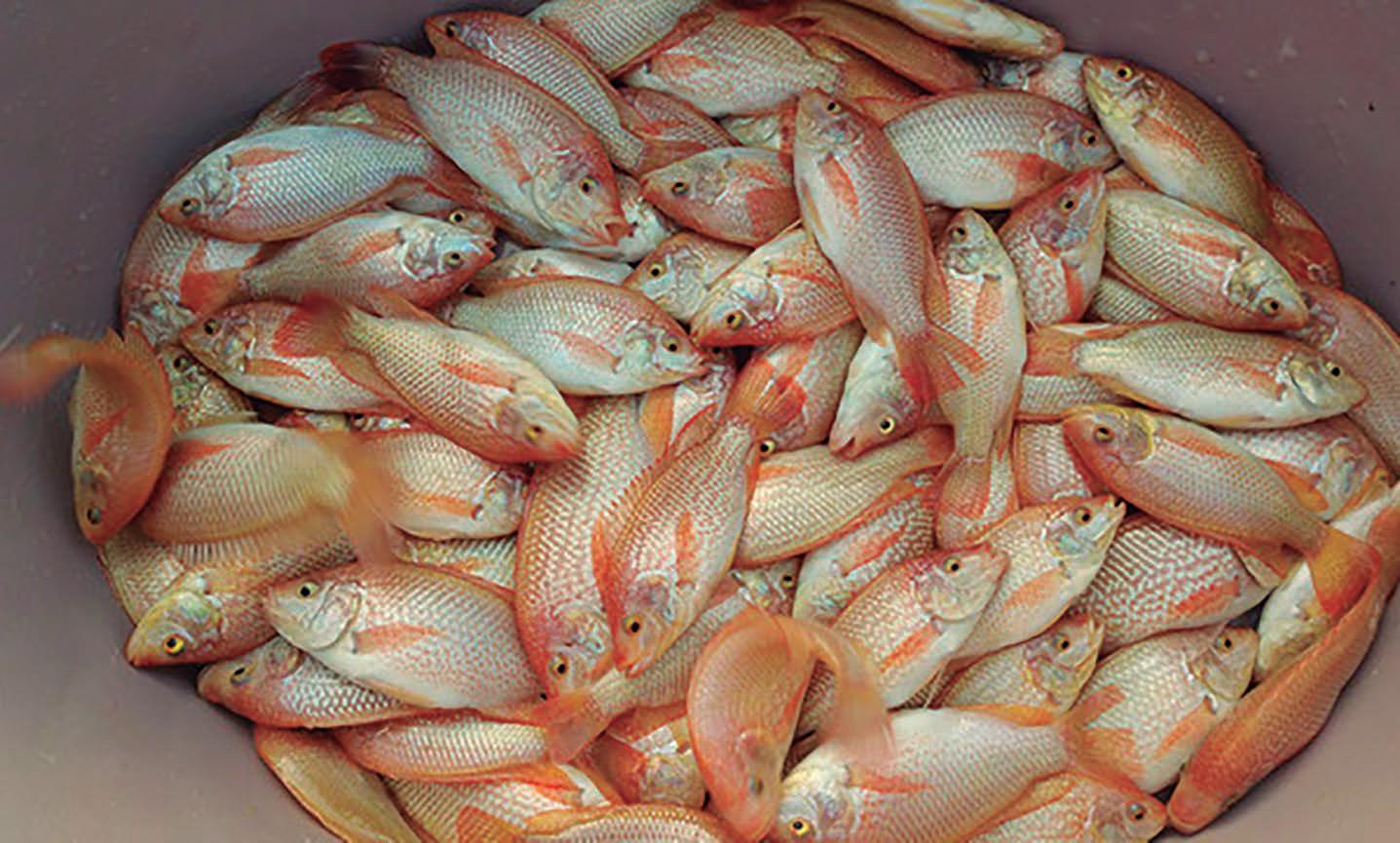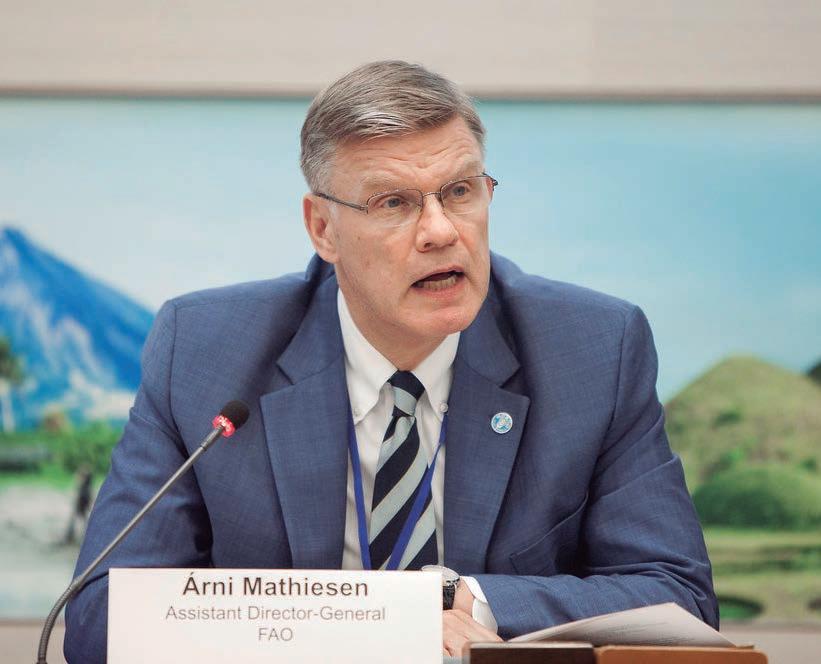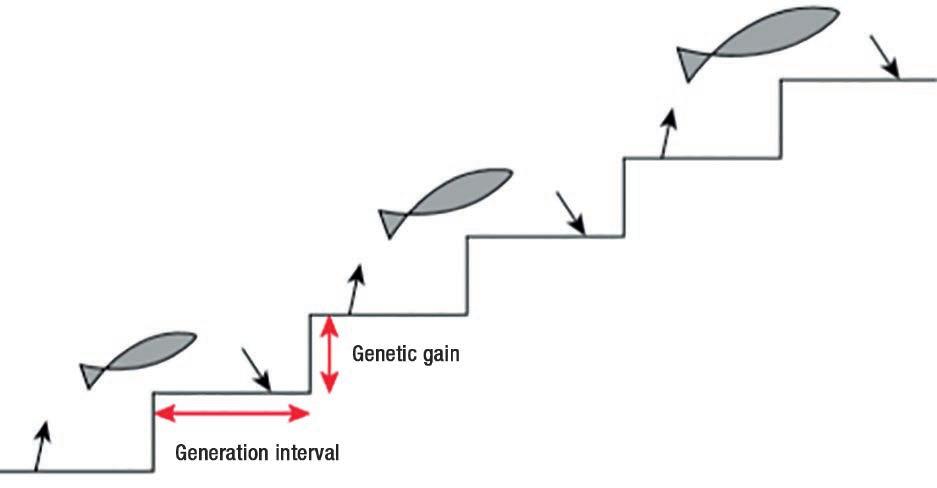
10 minute read
POST-HARVEST
Maintaining Raw Seafood Quality through Freezing
By: Evelyn Watts *
Seafood is one of the main sources of protein around the world, and its consumption continues to grow annually. Seafood is recognized to be highly perishable with a relatively short shelf life, because of its high unsaturated lipid composition. In addition, microbial and enzymatic activity also play important roles during fish spoilage. Appropriate chilling, refrigeration and freezing are key elements to maintain optimum quality of seafood products and are generally used as a preservation method onboard and onshore.
Chilling is the process to reduce the fish temperature to 32°F (0°C) (Figure 1). Chilling upon harvesting of seafood is necessary to slow down the spoilage process and maintain seafood quality. Ice is the most common and effective method of chilling. Fresh fish lasts for a few days refrigerated but it can be stored longer when frozen. Freezing is the process of removing heat from the seafood product to a temperature of -0.4°F (-18.0°C) or below (Figure 1). One of the great benefits of freezing is that it reduces microbial and enzymatic activity. A proper cold chain is required to maintain the benefits of freezing. If the frozen state is not accurate and continuous, it will result in a reduction of the quality of the product.
Freezing zone The fish tissue contains 75-80% water. The salts and other materials dissolved in the tissue decrease its freezing point below 32°F (0°C). Most water in the seafood will be frozen at -13°F (-25°C). However, much of the freezing and ice crystal formation will happen between 30.2°F (-1°C) and 23°F (-5°C), which is called the freezing zone or critical zone (Figure 1). The freezing zone needs to be accomplished quickly to obtain small ice-crystals, so that the formation of large ice-crystals and their disruptive effect on the cell walls are avoided. The ice-crystal formation starts with nucleation followed by the expansion of the crystals. A slow cooling rate results in the formation of a small number of ice nuclei. On the other hand, a rapid cooling rate results in the formation of a large number of nuclei. A greater number of nuclei will allow ice-crystals to remain small, limiting damage to the tissue.
Appropriate chilling of the fish to a temperature around 32°F (0°C) will subsequently allow more efficient freezing. Packaging material also plays an important role to prolong the freezing time. The heat transfer


coefficient and thickness of the packaging material, as well as air trapped between the packaging material and the food will result in the reduction of cooling rates.
The great advantage of an appropriate and efficient freezing process is the ability to achieve stability without damaging the initial quality of the fish. An efficient freezing process allows processors to achieve temperatures decreasing from 32°F to 23°F (0 -5°C) in the fish thermal center in less than 2 hours. The recommended
freezing and frozen storage temperatures for most fish products are -4 to -7.6°F (-20 to -22°C).
Recrystallization The ice crystals formed in the fish tissue are not stable and always tend to grow. During storage, the ice-crystals will tend to change in number, size, shape, and orientation. This phenomenon is known as recrystallization, resulting in small crystals disappearing, large crystals growing, and crystals fusing together.
Fluctuating temperatures greatly enhance the process of recrystallization. Increasing temperature allows the melting of ice-crystals. In the reverse process, nucleation of new crystals is formed and equilibrium is re-established by crystal growth. Recrystallization can be minimized by maintaining a low and constant storage temperature.
Recrystallization also happens during thawing. The thawing process should be done rapidly to avoid undesirable effects of recrystallization.
Freezer burn Excessive water loss during the freezing process due to the sublimation of water from the outer surface of the product will result in freezer burn. Freezer burn decreases the quality related with appearance and causes nutrient and quality loss. Freezer burn triggers lipid oxidation by the penetration of oxygen through porous structures. This is irreversible; however various measures can be used to minimize dehydration and freezer burn. Precooling with high humidity air at 39.4-41°F (4-5°C) will minimize dehydration during freezing. Packaging before freezing will also protect the product during the freezing process, however it delays freezing time and is not a correct choice for certain freezing methods. Another method is the application of a layer of ice on the already-frozen fish. This method is known as Glazing. Glaze can be accomplished by dipping the product in a glazing solution such as water, salt-sugar solutions or by spraying the product. Glazing can retard freezer burn and protect product from oxidation. Freezer burn is delayed due to the sublimation of the glaze instead of the moisture in the fish tissue.
The amount of glaze picked up by the product will depend on the size and shape of the product, glazing time, temperature of the fish and the glazing solution. Research reports that water uptake during glazing can range between 15% and 20%, which guarantees the final quality of the seafood product.
Freezing methods Air blast freezing Air blast freezing involves the application of air as the medium for freezing. The air is cooled by an evaporator, then circulated by fans over the product (Figure 2). Air speed should be 4-6 m/s for acceptable heat transfer and to maintain the temperature of the air at -22 to -40°F (-7.6 to -40°C). This freezing method is effective for packed foods. Air blast freezing unpacked fish will result in freezer burn and dehydration.

Figure 3
Schematic of a Fluidized Bed Freezer (Source: Shahnaz, A., 2017)

The most commonly used type of air blast freezing is tunnel freezing. In this method, the product travels on a belt moving slowly through a tunnel or enclosure containing very cold air in motion. Flow direction can be parallel or in an opposite direction to the movement of the product. The coldest air meets with the product closest to the frozen state and continues on its path through the tunnel. Warmer air at the end of the tunnel returns to the evaporator to be cooled again. Another air blast freezer method is fluidized bed freezers. In this method, the product is placed on a mesh conveyor exposed to forced air upward through the mesh, sufficient enough to lift or suspend the product
particles. Each particle is surrounded by cool air and freezes rapidly and individually (Figure 3). This is a suitable method for individually quick frozen (IQF) product. The product needs to be the same dimension and small enough to take fluidity. The cool air is fed perpendicularly to the belt and meets with the product according to the principle of countercurrents. Heat transfer is improved with the provision of controlled turbulence. This method is recommended for small sized seafood such as fish portions, fillets, shrimp, oysters and prawns. An advantage of this method is that it allows the consumer to meet the exact quantity requirements to be removed from the freezer. Big blocks
of fish or irregular size fish hanging on coils or trolleys can be frozen using this method. However, the major problem of this method is moisture loss from unpacked product.
Indirect contact freezing With this freezing method, the product is separated from the cooling medium (refrigerant) by conducting plates. The plates are often made of steel and equipped with evaporators. The contact of the product to the plate is important to guarantee the heat transfer. This method is recommended for products with regular geometry (rectangular cartons, slabs, fish sticks and fillets, or flat packages) (Figure 4) which can be placed between plates allowing for rapid freezing on both sides. Plate freezers can be either batch freezer or continuous mode.
Immersion freezing With this method, the product is frozen by immersion or spraying with a freezing agent. The freezing process occurs by the direct contact of the fish with a low freezing-point medium. An important factor to consider is that the solution does not change the texture or taste of the product. Other factors to consider when using this method are cost, flavor compatibility, safety, and ability to reduce so


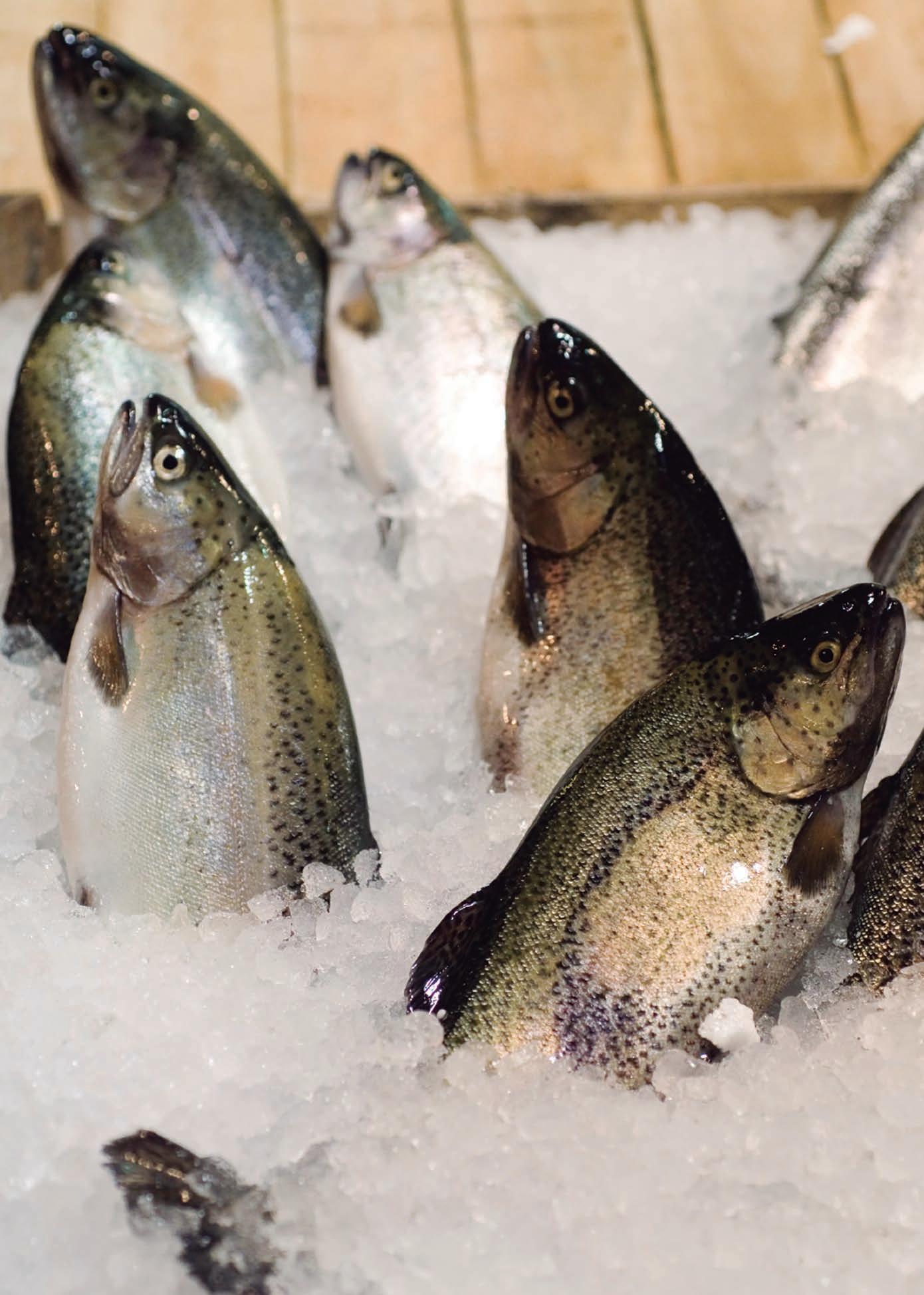
lution freezing point. Propylene glycol, glycerol, and mixtures of salt and sugar are common solutions used for this method. There are also combined solutions of alcohol/water and water/glycerol/alcohol. This method results in rapid freezing which leads to a high quality end product.
The immersion solution remains unfrozen at 32°F and below. A widely used solution is sodium chloride (salt) brine, which freezes at -5.8°F. A disadvantage of a salt brine solution is that the fish absorbs some salt. Brine freezing has been used in large fishing vessels that fish a considerable distance from their home port and stay at sea for long periods of time. This method is widely used for freezing tuna, shrimp and crab (Figure 5). This method is also commonly known as ‘IQF’ among commercial shrimpers.
Cryogenic freezing Another method that has been successfully applied to seafood products is cryogenic freezing. With this method, the food product is exposed directly to liquid boiling or solid subliming at a very low temperature. Liquefied gases with a very low boiling point are recognized as cryogenic liquids. Most commonly used food grade cryogenic freezing agents are liquid carbon dioxide and liquid nitrogen. The boiling point of liquid

carbon dioxide is -229°F (-145°C). Carbon dioxide sublimes at -110.2°F (-79°C) while absorbing 572kJ/kg of heat. On the other hand liquid nitrogen has a boiling temperature of -320.8°F (-196°C) and absorbs 199.8 kJ/kg of heat during vaporization. Liquid nitrogen is a safe food cryogenic compound because it is non-toxic, inert, protects oxygenic reactions, requires no extra cooling equipment, and ensures quick freezing at a very low temperature. In cryogenic freezing, the liquid is sprayed or dribbled on the product while passing through a tunnel on a conveyor belt (Figure 6). Cryogenic technology can be combined with other technol
Figure 6
Cryogenic tunnel (Source: www.praxairfood.com)

ogies such as antimicrobial coating or gamma radiation to reduce Listeria innocua or Salmonella spp.
Key points • Rapid freezing: a Accomplishes a good quality frozen product. a Small ice-crystals among cells provide physical protection to the cell structure. a Critical temperature zone must be achieved rapidly. a Inhibition of microbial degradation. • Recommended freezing and frozen storage temperatures for fish are -4 to -7.6°F (-20 to -22°C). • It is recommended to achieve reduction from 32°F to 23°F (0 to -5°C) in the center of the fish in less than 2 hours • Storage temperatures below -40°F (-40°C) allow the fish quality to be maintained for 6-9 months. However, it is not possible due to economical concerns.

DECEMBER 2019 - JANUARY 2020 Dr. Evelyn Watts has a Veterinary Medicine degree and a Master’s in Food Safety from the University of San Carlos in Guatemala, and a Doctorate in Food Science from Louisiana State University. She works with seafood processors in Louisiana assisting in regulatory compliance, as well as providing guidance on handling, processing, packaging and storage technologies.



